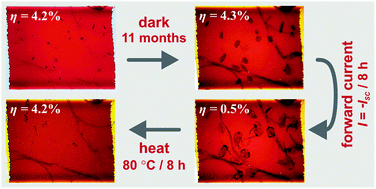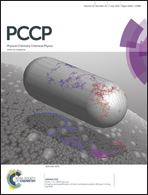Recovery of dye-sensitized solar cell's performance by heat treatment†
Abstract
The formation of iodine containing crystals with ageing in ionic liquid based dye-sensitized solar cells (DSSCs) containing an I3−/I− redox couple has already been confirmed. In this report we show how the size of these crystals can reversibly change during operation and the effects this has on cell performance. We also show how heat treatment and applied forward and reverse current treatment influence crystal growth in the cell. Crystal growth was tracked using electroluminescence and transmittance imaging, while current–voltage characterization and electrical impedance spectroscopy were used to measure cell performance and follow the changes in I3− diffusion, charge transfer resistance, and recombinations occurring in the DSSCs. Results reveal that applying a reverse current to the DSSC leads to the rapid formation of H2 bubbles while crystals grow rapidly when a forward current is applied. Additionally heat treatment at 80 °C can completely recover performance of a degraded cell showing visible defects and a large inhomogeneous active area.


 Please wait while we load your content...
Please wait while we load your content...